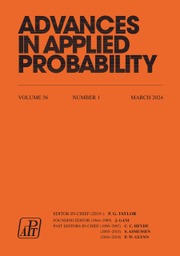Article contents
Improved queue-size scaling for input-queued switches via graph factorization
Published online by Cambridge University Press: 24 September 2020
Abstract
This paper studies the scaling of the expected total queue size in an  $n\times n$ input-queued switch, as a function of both the load
$n\times n$ input-queued switch, as a function of both the load  $\rho$ and the system scale n. We provide a new class of scheduling policies under which the expected total queue size scales as
$\rho$ and the system scale n. We provide a new class of scheduling policies under which the expected total queue size scales as  $O\big( n(1-\rho)^{-4/3} \log \big(\!\max\big\{\frac{1}{1-\rho}, n\big\}\big)\big)$, over all n and
$O\big( n(1-\rho)^{-4/3} \log \big(\!\max\big\{\frac{1}{1-\rho}, n\big\}\big)\big)$, over all n and  $\rho<1$, when the arrival rates are uniform. This improves on the best previously known scalings in two regimes:
$\rho<1$, when the arrival rates are uniform. This improves on the best previously known scalings in two regimes:  $O\big(n^{1.5}(1-\rho)^{-1} \log \frac{1}{1-\rho}\big)$ when
$O\big(n^{1.5}(1-\rho)^{-1} \log \frac{1}{1-\rho}\big)$ when  $\Omega\big(n^{-1.5}\big) \le 1-\rho \le O\big(n^{-1}\big)$ and
$\Omega\big(n^{-1.5}\big) \le 1-\rho \le O\big(n^{-1}\big)$ and  $O\big(\frac{n\log n}{(1-\rho)^2}\big)$ when
$O\big(\frac{n\log n}{(1-\rho)^2}\big)$ when  $1-\rho \geq \Omega(n^{-1})$. A key ingredient in our method is a tight characterization of the largest k-factor of a random bipartite multigraph, which may be of independent interest.
$1-\rho \geq \Omega(n^{-1})$. A key ingredient in our method is a tight characterization of the largest k-factor of a random bipartite multigraph, which may be of independent interest.
Information
- Type
- Original Article
- Information
- Copyright
- © Applied Probability Trust 2020
References
- 1
- Cited by


